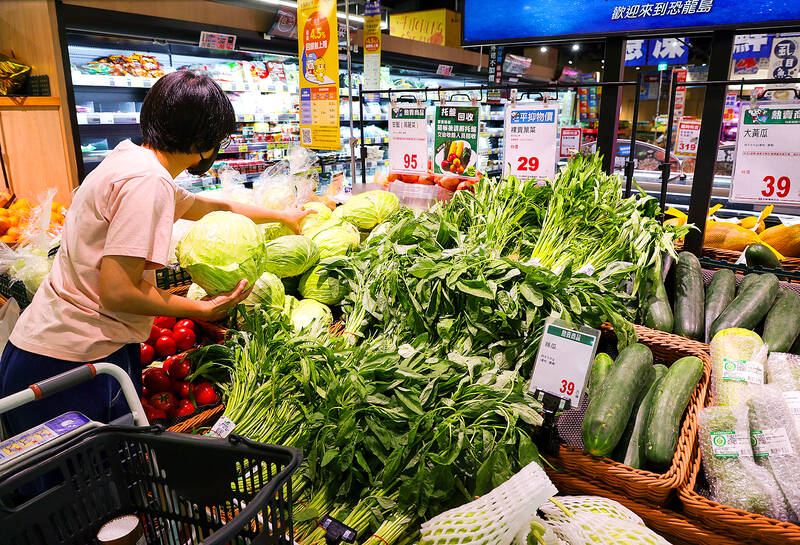The government yesterday offered rare details of its wartime food plan, saying it is taking monthly inventories of crucial supplies such as rice and making sure they are properly stored across the nation in case of a Chinese blockade.
China has over the past five years staged almost daily military activities around Taiwan, including war games that have practiced blockades and attacks on ports.
China’s latest war games around Taiwan, carried out last week, included mock blockades of key ports and areas, and assaults of maritime and ground targets, Beijing said.

Photo: CNA
In a report to the Legislative Yuan about preparations in case of a Chinese blockade, a copy of which was reviewed by Reuters, the Ministry of Agriculture said it has ensured that rice stockpiles were above a three-month level as required by law and that food supplies were stored across the nation in a bid to “lower attack risks.”
Current rice stocks are enough to support the nation for at least seven months and plans on rice rationing through supply stations across the country are being made in case of a food crisis, the ministry said.
During a blockade, more farmland would be used to grow rice, the ministry said, adding that it would prioritize growing sweet potatoes, soybeans and fresh vegetables, as well as using more ponds for aquaculture.
In a scenario in which sea fishing is not allowed, the ministry said the nation’s fish feed inventory would be enough to support fishing in ponds for more than three months.
The ministry said it was planning to set up a task force to ensure food supply safety by taking a monthly inventory of the nation’s food resources.
Taiwan, a farming powerhouse during Japanese colonial rule from 1895 to 1945, depends on imports for the majority of its food needs as farm land was taken over for factories during rapid industrialization starting in the 1960s.
Taiwan’s food self-sufficiency rate last year dropped to an 18-year low of 30.3 percent, a previous report from the ministry said.
In a separate report to the legislature on preparations for the same scenario, the National Security Bureau said China’s cyberforces were honing their skills to infiltrate key online infrastructure such as telecoms in a bid to destabilize Taiwan with misinformation during a conflict with China.
Additionally, over the past two years, China has carried out “joint combat readiness patrols” near Taiwan three to four times per month, it added.
The number of tanker aircraft used for aerial refueling, landing ships and other forces participating in the training has been gradually increased, it said.
“This underscores that the communist military has continued to escalate its military threat against Taiwan in an effort to establish a blockade and control of our external sea lines of communication,” the bureau said.

SHIPS, TRAINS AND AUTOMOBILES: The ministry has announced changes to varied transportation industries taking effect soon, with a number of effects for passengers Beginning next month, the post office is canceling signature upon delivery and written inquiry services for international registered small packets in accordance with the new policy of the Universal Postal Union, the Ministry of Transportation and Communications said yesterday. The new policy does not apply to packets that are to be delivered to China, the ministry said. Senders of international registered small packets would receive a NT$10 rebate on postage if the packets are sent from Jan. 1 to March 31, it added. The ministry said that three other policies are also scheduled to take effect next month. International cruise ship operators

HORROR STORIES: One victim recounted not realizing they had been stabbed and seeing people bleeding, while another recalled breaking down in tears after fleeing A man on Friday died after he tried to fight the knife-wielding suspect who went on a stabbing spree near two of Taipei’s busiest metro stations, Taipei Mayor Chiang Wan-an (蔣萬安) said. The 57-year-old man, identified by his family name, Yu (余), encountered the suspect at Exit M7 of Taipei Main Station and immediately tried to stop him, but was fatally wounded and later died, Chiang said, calling the incident “heartbreaking.” Yu’s family would receive at least NT$5 million (US$158,584) in compensation through the Taipei Rapid Transit Corp’s (TRTC) insurance coverage, he said after convening an emergency security response meeting yesterday morning. National

PLANNED: The suspect visited the crime scene before the killings, seeking information on how to access the roof, and had extensively researched a 2014 stabbing incident The suspect in a stabbing attack that killed three people and injured 11 in Taipei on Friday had planned the assault and set fires at other locations earlier in the day, law enforcement officials said yesterday. National Police Agency (NPA) Director-General Chang Jung-hsin (張榮興) said the suspect, a 27-year-old man named Chang Wen (張文), began the attacks at 3:40pm, first setting off smoke bombs on a road, damaging cars and motorbikes. Earlier, Chang Wen set fire to a rental room where he was staying on Gongyuan Road in Zhongzheng District (中正), Chang Jung-hsin said. The suspect later threw smoke grenades near two exits

The Forestry and Nature Conservation Agency yesterday launched a gift box to market honey “certified by a Formosan black bear” in appreciation of a beekeeper’s amicable interaction with a honey-thieving bear. Beekeeper Chih Ming-chen (池明鎮) in January inspected his bee farm in Hualien County’s Jhuosi Township (卓溪) and found that more than 20 beehives had been destroyed and many hives were eaten, with bear droppings and paw prints near the destroyed hives, the agency said. Chih returned to the farm to move the remaining beehives away that evening when he encountered a Formosan black bear only 20m away, the agency said. The bear